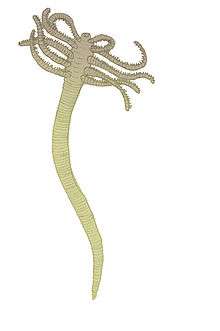Facivermis
| Facivermis Temporal range: Lower Cambrian Chengjiang | |
|---|---|
 | |
| Reconstruction of Facivermis | |
| Scientific classification | |
| Kingdom: | Animalia |
| Superphylum: | Ecdysozoa |
| Genus: | †Facivermis Hou & Chen 1989 |
| Species | |
| |
Facivermis (meaning "torch worm" [1]) is an enigmatic organism from the Lower Cambrian Maotianshan shales of China [2]
Anatomy
Facivermis was a worm-like creature up to 55 mm long. Its body was divided into three sections. The anterior section had five equally sized pairs of appendages with two setal rows along the margins. The middle section was elongate and five times longer than the anterior or posterior. The posterior section was pear-shaped and had three rows of hooks surrounding the anus.[2]
Classification
Facivermis was considered by its describers to be a polychaete worm.[1] An affinity to the unusual crustacean lineage Pentastomida has also been proposed, but is seen as unlikely.[2][3] Since its discovery, however, most evidence has supported its being a lobopodian.[2][3] Liu et al. draw a comparison to the known lobopodian Miraluolishania. Liu et al. also note that the pear-shaped end bears a close resemblance to the proboscis of priapulid worms if it is interpreted as being the anterior end.[2] The possible priapulid "Xishania" longiusula's fragmentary remains closely resembles the pear-shaped end of Facivermis, so Huang et al. assigned "X". longiusula to Facivermis as a second species.[2][4]
Ecology
Facivermis was probably a predator that anchored itself into sediment with its hooked posterior end and used its anterior appendages to catch prey.[2] One fossil has a possible bradoriid preserved in its gut.[1]
References
- 1 2 3 Hou, X.; Chen, J. (1989). "Early Cambrian tentacled worm-like animals (Facivermis gen. nov.) from Chengjiang, Yunnan". Acta Palaeontologica Sinica. 28 (1): 32–42.
- 1 2 3 4 5 6 7 Liu, J.; Han, J.; Simonetta, A. M.; Hu, S.; Zhang, Z.; Yao, Y.; Shu, D. (2006). "New observations of the lobopodian-like worm Facivermis from the Early Cambrian Chengjiang Lagerstätte". Chinese Science Bulletin. 51 (3): 358–363. doi:10.1007/s11434-006-0358-3.
- 1 2 Delle Cave, L.; Insom, E.; Simonetta, A. M. (1998). "Advances, diversions, possible relapses and additional problems in understanding the early evolution of the Articulata". Italian Journal of Zoology. 65 (1): 19–38. doi:10.1080/1125000980938672.
- ↑ Huang D.; Cai C.; Chen A. (2012). "The homonymy of Xishania with reference to Xishania fusiformis Hong, 1981 and X. longisula Hu, 2002". Acta Palaeontologica Sinica.